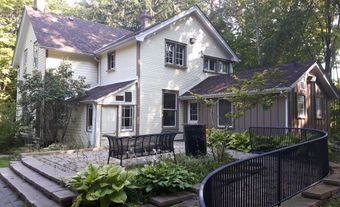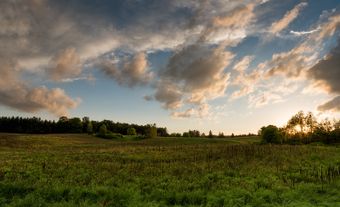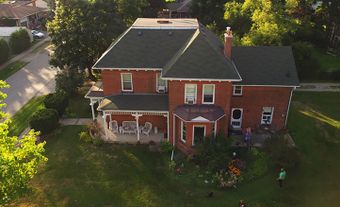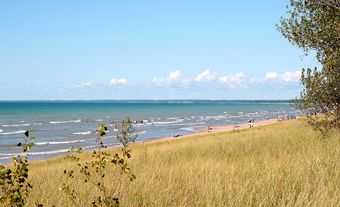Brampton, Ontario, incorporated as a city in 1974, population 656,480 (2021 census), 593,638 (2016 census). The city of Brampton was created by the amalgamation of the Town of Brampton, the southern half of Chinguacousy Township, and portions of the Town of Mississauga and Toronto Gore Township. Located northwest of Toronto, Brampton is part of the Regional Municipality of Peel. It is located within the Credit and Humber River watersheds. Throughout history, the Brampton area has been home to different Indigenous groups, namely the Wendat (Huron), Haudenosaunee and Anishinaabeg, including the Mississaugas of the Credit. The land is covered by the Ajetance Purchase (1818).
Indigenous Peoples
Indigenous peoples have lived in the Brampton area for thousands of years, particularly near the Credit and Humber rivers. The Wendat (Huron) farmed vegetables, fished, hunted and lived in longhouses. When Europeans arrived in the 1600s, French traders allied with the Wendat and became enemies with the Haudenosaunee. The Iroquois Wars, fought in part over the control of the fur trade during the 17th century, depopulated the Wendat. Diseases introduced by the Europeans also decimated the Wendat population.
In the early 1700s, the Haudenosaunee left the Humber watershed for their territory in upper New York State. Their withdrawal led to the migration of Anishinaabeg peoples, including the Mississauga, to the Brampton area.
In 1818, James Ajetance, chief of the Mississaugas of the Credit, signed an agreement with the British colonial government. The agreement, which became known as the Ajetance Purchase or Treaty 19, surrendered 2,622 km2 of Mississauga land to the Crown (see also Upper Canada Land Surrenders). In exchange, the Mississaugas of the Credit were to receive 522 pounds and 10 shillings in goods every year. In 1847, the Mississaugas of the Credit moved to their present-day location near Hagersville, Ontario, adjacent to the Six Nations of the Grand River reserve. Today, Indigenous peoples make up 0.5 per cent of Brampton’s population.
Settlement and Development

In 1819, a British soldier named Richard Bristol surveyed Chinguacousy Township. Other English settlers began arriving in 1820. In the 1830s, Brampton was established just south of Chinguacousy Township. Originally known as Buffy’s Corners, Brampton was renamed for a town in Cumberland, England when it was incorporated as a village in 1853. The village was located at the intersection of Hurontario and Queen streets, on a floodplain of the Etobicoke Creek. In 1867, electors chose Brampton as the location of Peel County’s government. This decision, in addition to the arrival of the Grand Trunk Railway in 1858, spurred economic development. In 1873, Brampton was incorporated as a town.
Early settlements near the Town of Brampton (now within the City of Brampton) included Nortonville, Snelgrove, Huttonville, Mayfield, Castlemore, Stanley’s Mills, and Churchville.

Most post-war housing and industrial developments were built within the town’s ever-expanding limits. One exception was Bramalea, designed to be separate from both Brampton and Malton. It was dubbed a “satellite city” (see Urban Design). The first houses in Bramalea were built in 1959, with construction continuing to the 1980s.
The Province of Ontario began reviewing various municipalities in the mid-1960s. Peel County was facing increasing growth and urbanization. The abilities of its 10 municipal governments varied greatly. By combining them into three municipalities, each could better react to and plan for the complex needs of residents. To this end, in 1974 the provincial government created Caledon, Mississauga and Brampton. The City of Brampton was created from the Town of Brampton, Toronto Gore Township, the southern half of Chinguacousy Township, and a portion of the Town of Mississauga.
After amalgamation, swaths of agricultural land within the city borders began to be developed. Brampton became known as a “bedroom community,” despite having major industry. In recent years, planners have looked to redevelop areas of the city with high density.
Population
Brampton is Canada’s ninth-largest city (see also Largest Cities in Canada by Population). It is also the third-largest city in the Greater Toronto Area, after Toronto and Mississauga.
Brampton’s population is ethnically diverse. Over 52 per cent of residents identify as South Asian, according to the 2021 census. Other prominent ethnic groups within Brampton include Canadian (6.2 per cent), Jamaican (4.8 per cent) and English (4.2 per cent). Common places of origin for immigrants living in Brampton include India, the Americas and Europe.
In addition, as of the 2021 census, Brampton had the second largest population of Sikhs in Canada, following Surrey, British Columbia.
Economy and Labour Force

Brampton is located on prime agricultural land and was largely used for farming until recent decades. Jersey cattle from breeders B. H. Bull and Son set milk-production records, and a Holstein bull from Rosafe Farms fathered Cuba’s dairy herd for decades. During the 1920s, nearly half of Canada’s cut flowers were from Brampton’s Dale Estate greenhouses. The various greenhouses attracted immigrants, in particular skilled Dutch workers. Operation costs and competition from South America ended the business in 1980.
Throughout much of the mid-1800s to the mid-1900s, the Town of Brampton’s economy was industrial. Prominent companies included Gummed Papers, agricultural equipment foundry Haggert Bros., Hewetson Shoes, and Dixie Cup.
Both Loblaw Companies Limited and the Hudson’s Bay Company have head offices in Brampton. Nortel’s former head offices are now a campus of Rogers Communications. The Brampton office of MDA operates and maintains robotics on the International Space Station, including Canadarm2 and Dextre.
Sheridan College and Algoma University have campuses in the city.
Government and Politics
Bill Davis, the Ontario Premier from 1971 to 1985, has lived in Brampton his entire life. Davis is cited as an inspiration to Patrick Brown, the former leader of the Progressive Conservative Party of Ontario. Brown was elected Mayor of Brampton in 2018.
Jagmeet Singh served as the Member of Provincial Parliament for Brampton East, before being chosen as federal NDP leader. Alberta Senator Sir James Alexander Lougheed and Manitoba Premier Tobias Crawford Norris are also from Brampton. Another Manitoba Premier, Howard Pawley, went to high school in Brampton.
Cultural Life

The Brampton Excelsiors lacrosse team, formed in 1871, won the Mann Cup 11 times, most recently in 2011. In 2020, the team moved to Owen Sound, Ontario. Hockey Hall of Fame inductee Jayna Hefford played for the defunct Brampton Thunder, as did Cassie Campbell-Pascall. Basketball player Andrew Wiggins and tennis player Milos Raonic are also from Brampton.
Brampton has eight library branches, as well as The Rose Theatre, Bovaird House, and the Peel Art Gallery, Museum and Archives. The Festival of Literary Diversity, founded in 2016, has received national attention. Singer Alessia Cara, playwright trey anthony, actor Michael Cera, actor-comedian Scott Thompson, and paleontologist Phillip J. Currie are all from the city.

 Share on Facebook
Share on Facebook Share on X
Share on X Share by Email
Share by Email Share on Google Classroom
Share on Google Classroom







